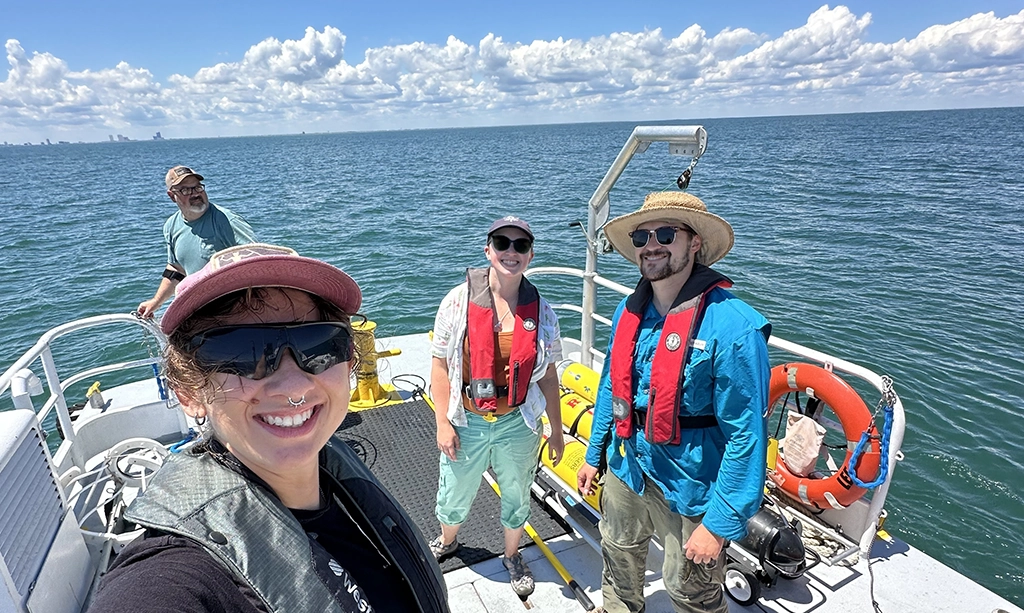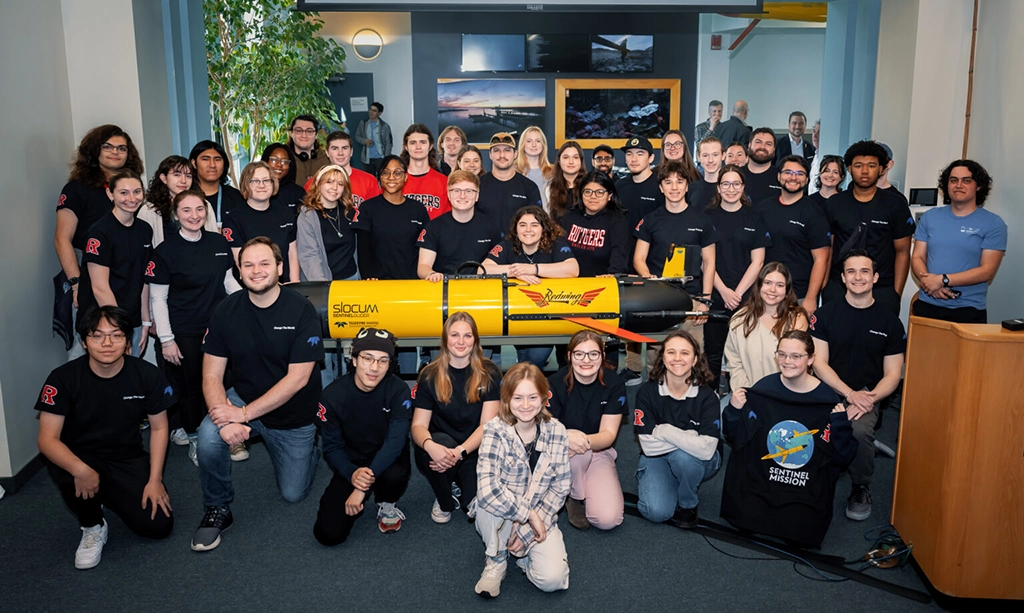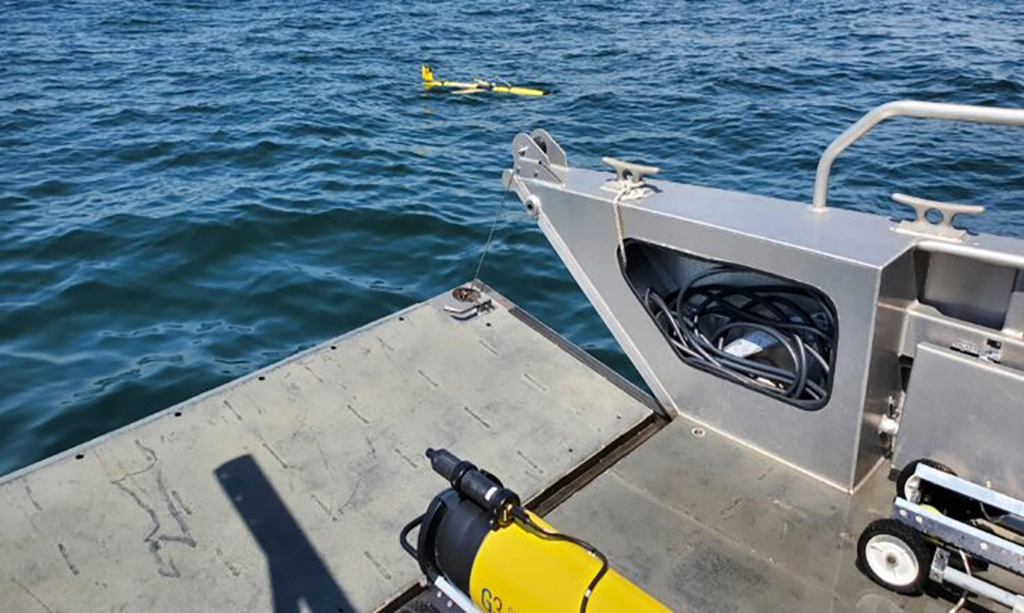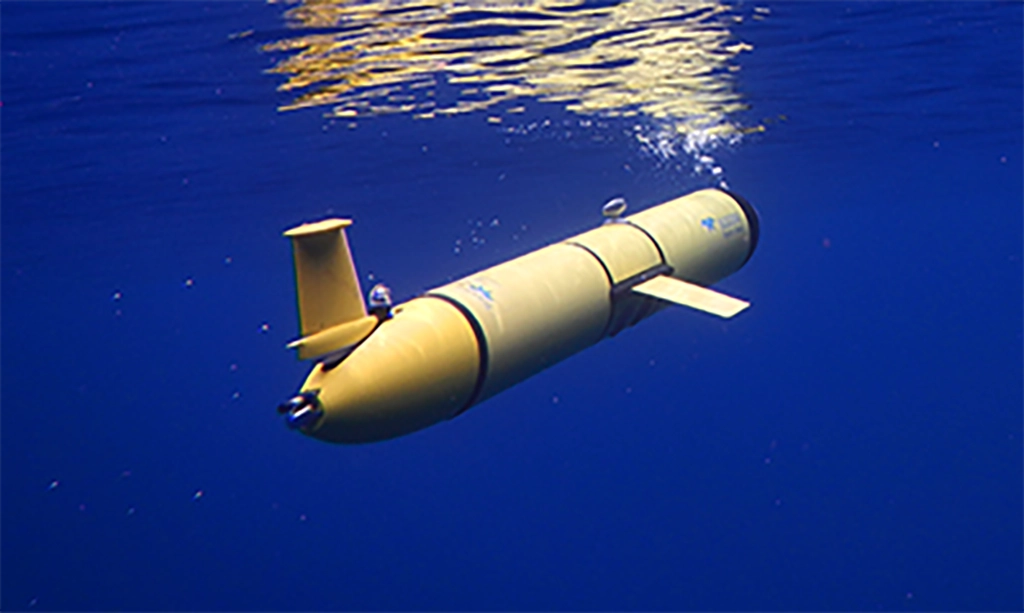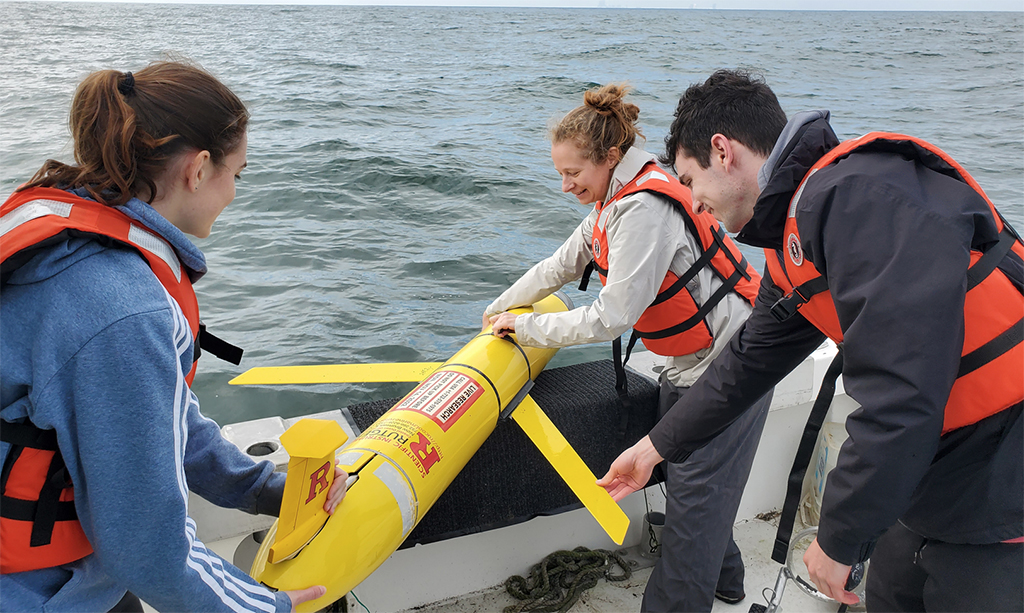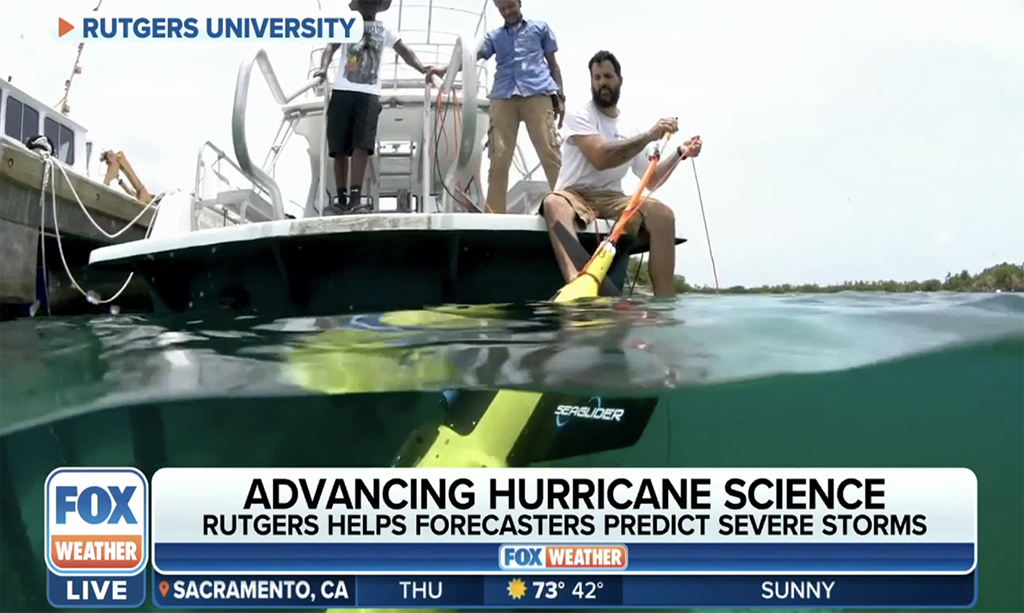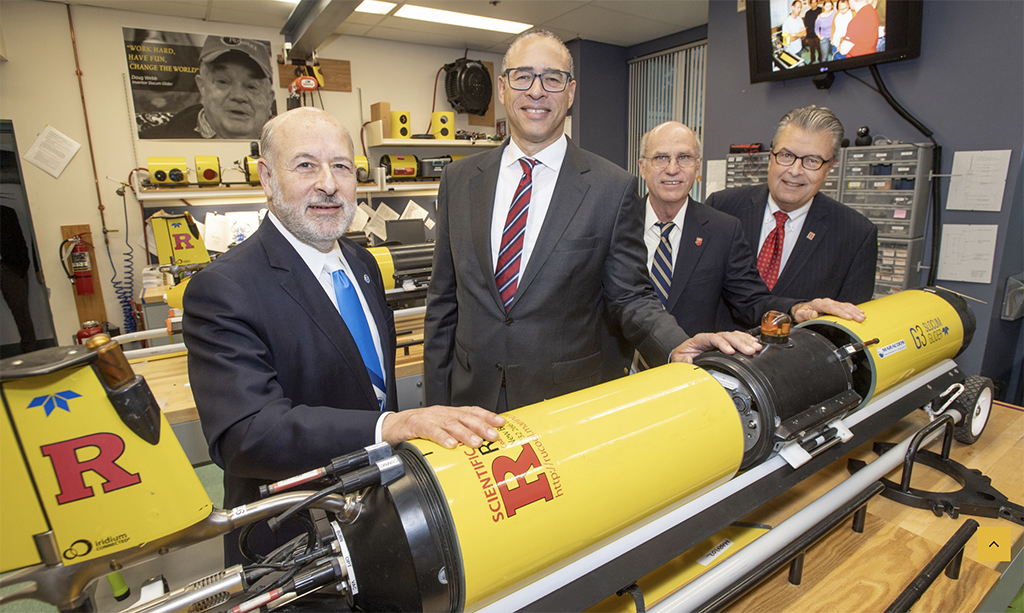RU39 and RU40 for the Spring RMI, and RU32 for NJDEP have been recovered by Brian, Jess, and Delphine aboard SeaTow on a nice sunny day in Atlantic City!
Rutgers University and Teledyne Webb Research unveiled The Sentinel Mission in a remarkable display of academic and technological collaboration. This unprecedented initiative marks the beginning of an ambitious journey as Teledyne’s Slocum Sentinel Glider, “Redwing,” (Research & Education Doug Webb Inter-National Glider) prepares for a historic round-the-world flight. Redwing is an acronym for “Research & Education Doug Webb Inter-National Glider”. The mission is further strengthened by the involvement of NOAA, the Marine Technology Society, and the UN Ocean Decade. The event, which took place at Rutgers University on April 23, showcased the intricate planning and resilient partnership behind The Sentinel Mission. The Redwing glider, embodying the intersection of Research and Education, pays homage to Doug Webb, a pioneer of autonomous underwater technology. The glider stands not only as an innovative piece of machinery but also as a symbol of global research unity and exploration. Rutgers President Jonathan Holloway delivered remarks, along with several esteemed faculty members, each sharing their encouragement and support of this mission. Teledyne Marine staff members, Clayton Jones, Senior Director of Technology and Shea Quinn, Slocum Glider Product Line Manager, provided insight into the history of Slocum gliders and how this mission will affect the future of ocean science. A highlight of the event was the christening of the glider, “Redwing,” with seawater from Cape Cod, signifying its readiness for its summer 2024 launch. Attendees witnessed a blend of time-honored maritime tradition with cutting-edge innovation. A cohort of Rutgers’ brightest undergraduate students presented the mission’s flight path. Their extensive planning encompassed considerations for ocean currents, water conditions, and other environmental variables. These presentations highlighted the exceptional educational experiences at Rutgers, exemplifying the university’s dedication to hands-on, impactful learning. Insights from international partners integral to the mission’s global scope further enriched the event. With each presentation, the essence of collaborative spirit and international cooperation became clearer, setting the stage for a truly global expedition. The day’s activities culminated with a closer look at the Sentinel Glider, showcasing its capabilities compared to standard models. The academic community, including master’s students and faculty, engaged in fruitful discussions about sensor integrations and future research applications. The Sentinel Mission’s anticipated launch in the summer of 2024 will contribute to our understanding of the oceans and serve as an inspiring testament to the power of academic-industry partnerships and the indomitable human spirit of discovery. About Teledyne Webb Research: Teledyne Marine is a group of leading-edge technology companies that are part of Teledyne Technologies Incorporated. Through acquisitions and collaboration, Teledyne Marine has evolved into an industry powerhouse, bringing Imaging, Instruments, Interconnect, Seismic, and Vehicle technology to provide solutions to our customers. For more information, please visit www.teledynemarine.com. About Rutgers University: Rutgers University is a leading national research institution that has consistently pushed the boundaries of innovation and education. The Sentinel Mission represents the university’s commitment to exploring new frontiers. For more information on the mission’s background and Rutgers’ history with such initiatives, please visit the Challenger Glider Mission website at www.rutgers.edu. Original article at Rutgers NJAES Newsroom
This article was authored by Grace Saba, associate professor, and Josh Kohut, professor, faculty in Rutgers University’s Center for Ocean Observing Leadership (RUCOOL) in the Department of Marine and Coastal Sciences. From late April to late September, Rutgers researchers used underwater robots, called gliders, to track ocean water quality along the New Jersey coast. Through a series of glider deployments, water quality measures of oxygen concentrations and pH were mapped from surface to bottom along the New Jersey coast. From August through September, much of the bottom water sampled from Sandy Hook south to Tuckerton, and from nearshore (15 meter, or 50 feet, water depth) to deeper depths (60 meter, or 200 feet, water depth), exhibited dissolved oxygen concentrations less than 5 mg/liter and pH values less than 7.75. Coast-wide, hypoxic levels of dissolved oxygen (concentrations < 3 mg/liter) were observed at shallower, more inshore locations. In addition to low pH measured in bottom waters, which is indicative of ocean acidification, aragonite saturation state (a relevant metric for biological impacts of ocean acidification) was calculated to be < 1 in several locations. Normal, more optimal levels in seawater typically include dissolved oxygen concentrations > 7 mg/liter, pH of 8.1, and aragonite saturation states > 3. Saba and Kohut discuss the implications for their summer observations of low dissolved oxygen and pH off the coast of New Jersey, and offer some next steps in their research. Why are these values concerning? As is true for land animals, oxygen is essential to ocean animals. Dissolved oxygen concentrations at or below 5 mg/liter is considered problematic for marine life. Although concentrations between 3-5 mg/liter may not be low enough to directly cause death in many marine animals, research focused on New Jersey species has identified other negative impacts such as reduced metabolism, feeding, growth, and reproduction at these levels. Lower hypoxic concentrations of dissolved oxygen (< 3 mg/liter) have been directly associated with mortalities in some organisms in New Jersey and in other coastal regions around the world. Increased carbon dioxide in seawater leads to a series of chemical reactions that increases the acidity of the ocean (measured as a reduction in pH) and reduces carbonate ions that are vital to the production of shells and other protective structures of marine animals (made of calcium carbonate, such as aragonite). As such, aragonite saturation state is used as an indicator of ocean acidification because as the ocean absorbs atmospheric carbon dioxide, both pH and aragonite saturation state decrease, and can lead to reduced survival, calcification rates, growth, and reproduction in marine animals. When aragonite saturation state is less than 1, shells and other calcium carbonate structures begin to dissolve, but some organisms become susceptible at levels below 3. Any one stressor may not itself be an issue due to the resiliency of many coastal species to fluctuating natural environmental conditions. However, when more than one stressor occurs simultaneously, an organism may become unable to fully withstand changes. The impacts of multiple stressors occurring simultaneously on organism health is much less well known. The co-occurrence of low dissolved oxygen and pH may exacerbate negative responses in organisms, or increase their susceptibility to either or both oxygen and pH. Left: Mission tracks of three gliders (ru28, ru39, ru40) deployed off the coast of New Jersey in August and September. Gliders ru39 and ru40 were deployed as a pair along the same mission track. All gliders had sensors measuring temperature and salinity. Gliders ru28 and ru40 each had an additional sensor measuring dissolved oxygen (no pH or aragonite saturation state), and glider ru39 had an additional sensor measuring pH (no dissolved oxygen). Right: Locations of hypoxic levels of dissolved oxygen (magenta; < 3 mg/liter) and low aragonite saturation state (cyan; < 1) measured along the glider mission tracks and locations of reported fish, lobster, and/or crab mortalities (red X). Complete cross-sections of dissolved oxygen concentrations (left top and bottom), pH (right top), and aragonite saturation state (right bottom) measured along the mission tracks during the deployments of the three gliders (ru28, ru39, ru40) during August and September. Dissolved oxygen concentrations between 3-5 mg/liters are expressed as orange & yellow, and hypoxic concentrations < 3 mg/liter are expressed as red. pH values < 7.75 and aragonite saturation states < 1 are highlighted in cyan. Reports of fish, lobster, and crab mortalities During the time when low dissolved oxygen and pH were observed, numerous mortalities of fish, lobsters and crabs within the sampling area were reported. The mortalities were observed in bottom waters primarily off the coast of Monmouth and Ocean Counties and included the Mud Hole, as far east as Lillian wreck, and southward in Sea Girt and Axel Carlson Reefs and the surrounding areas. Mortalities were reported for American lobsters, Jonah crab, Atlantic rock crab, spider crabs, black sea bass, and tautog were reported not only in pots where trapped organisms would not have been able to escape poor conditions, but also on the open bottom. This observation suggests that if low dissolved oxygen and/or pH were indeed the culprit for these reported mortalities, the area may have been extensive enough that they could not escape in time. Mortalities associated with low dissolved oxygen in New Jersey coastal waters or other locations is not new. The most extreme hypoxic event documented in the State occurred during the summer of 1976, whereby mass mortalities of marine organisms occurred over a 12,000 km2 area. More recently, numerous fish, lobster, and crab mortalities were associated with low dissolved oxygen in Cape Cod Bay in September 2019, and hypoxic conditions have been identified as the culprit of mortalities and changes in bottom water communities in the Gulf of Mexico’s notorious summer-time ‘Dead Zone’ since the beginning of annual observations that started in 1985. What causes low dissolved oxygen and pH in bottom water? A common seasonal phenomenon in New Jersey coastal shelf waters is strong summer stratification whereby cold water near the bottom is capped off by
On October 28, 2003, the Rutgers University Center for Ocean Observing Leadership (RUCOOL) deployed Slocum Glider RU03 from the Rutgers University Marine Field Station (RUMFS) in Tuckerton, NJ on Rutgers first underwater glider mission across the New Jersey continental shelf. The transect would come to be known as the Tuckerton Endurance Line. Since that first deployment 20 years ago, RUCOOL has conducted over 650 Glider missions, has flown underwater over 340,000 km (over 8 times around the world) and has has been at sea for over 17,700 days (nearly 50 years). Glider missions have taken Rutgers scientists, researchers and students to all 7 ocean basins and both polar seas. Up to date statistics can be found here. Congratulations to all of RUCOOL for making the Jersey Roots, Global Reach slogan a reality.
New students Leslie Birch, Emily Busch, Bre DiRenzi, Rhyan Grech, Yachen Li, and Jake Zappala worked together to ensure the successful deployment and recovery of RU23. The students prepared and deployed the glider on October 11th. For 3 weeks, the students piloted the glider on their own mission: to transect along the Endurance Line and back, and to learn while doing so. Earlier this week, the students successfully recovered RU23 alongside Captain Chip Haldeman aboard the R/V Resilience. Glider RU23, once famous for its service during Superstorm Sandy in 2012, had settled into retirement nearly 7 years ago. Seeing a clear learning opportunity, the students worked alongside the RU COOL glider team in restoring and preparing the glider for another mission. The students split in teams, half on the water for deployment and half in the COOL room for piloting. The MOO cohort deployed the glider with bated breath, despite the potential risk of a leak due to the RU23’s age. With guidance from the RU COOL glider team, the students piloted the glider, adjusting the mission trajectory around storms, ship traffic, and ocean currents. RU23 and the students managed to locate the strong signal of the Mid-Atlantic cold pool in an otherwise well-mixed shelf before turning the glider around and heading it back to Tuckerton, NJ. With the glider now safely home after a successful mission, the students have begun the cleaning and readying of the glider for another round in the winter or spring. The experiential nature of this deployment, from mission conception through deployment, from piloting to recovery, and with data analyses ongoing throughout, is unique to the Rutgers Master’s of Operational Oceanography program. By providing opportunities to learn not just the science but the technologies used to collect that science, and to be part of a real-time ocean observing team, the graduates of the program leave with the skills to be highly competitive in any research or industry career.
Travis Miles, Professor of Marine and Coastal Sciences at Rutgers University, explains how ocean robots, known as gliders, have improved the accuracy of forecasts. Full video at Fox Weather
Rutgers, NOAA and glider maker mark RUCOOL milestone For 30 years Rutgers’ Center for Ocean Observing Leadership (RUCOOL) has taken the lead in pioneering research that has changed our understanding of the oceans and the way information is collected. National Oceanic and Atmospheric Administration (NOAA) Administrator Rick Spinrad joined Rutgers President Jonathan Holloway and marine and coastal science researchers and students last week to celebrate the accomplishments of RUCOOL and to look back at the research gains made since Superstorm Sandy 10 years ago. “I’m really proud of everything that’s going on here at Rutgers,” said Spinrad, who has supported the research efforts of Rutgers faculty and students, led by RUCOOL co-director Scott Glenn, a Distinguished Professor in the Department of Marine and Coastal Sciences, and department chair and Distinguished Professor Oscar Schofield. Working with government, industry, and academic partners, RUCOOL guides underwater gliders that provide observational data – combined with data gathered from planes that fly into hurricanes and the Argo fleet of robotic instruments that drift with the ocean currents and move between the surface and a mid-water level – to deliver more accurate views of ocean activity in hurricane models. The resulting models lead to better hurricane monitoring by NOAA and forecasting by the National Weather Service. “As the land grant institution of New Jersey, Rutgers recognizes our key role in equipping our local communities and all of our 21 counties with the research and information needed to prepare for the change in climate,” Rutgers President Jonathan Holloway said. He congratulated the RUCOOL team for three decades of service to the state, country, and world last week at the Department of Marine and Coastal Sciences in the School of Environmental and Biological Sciences at Rutgers-New Brunswick. Spinrad recalled early discussions decades ago with Glenn and Schofield about the idea of sending a glider across the Atlantic Ocean to gather needed data and information. Spinrad and Rutgers alumnus Craig McLean, recently retired as assistant administrator of NOAA Research, supported Rutgers researchers as they developed the glider technology with Teledyne Webb Research. Today, Rutgers is the third-largest operator of ocean gliders behind only the National Science Foundation and the U.S. Navy and the technology deployed is more important than ever. “Hurricane Harvey dumped five feet of rain on the Houston area. Ian dumped two feet of rain in Florida. These are different storms,” Spinrad said, noting the increasing intensity of hurricanes. “They’re massive storms. They’re slow. They’re powerful. Our ability to get the observations, build the models and make the predictions is becoming even more critical.” Full article at Rutgers Today

